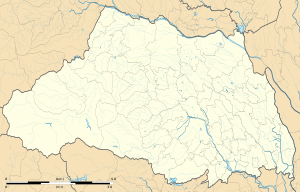Minami-Koshigaya Station
Minami-Koshigaya Station (南越谷駅, Minami-Koshigaya-eki) is a railway station on the Musashino Line in Koshigaya, Saitama, Japan, operated by East Japan Railway Company (JR East).[1]
JM22 Minami-Koshigaya Station 南越谷駅 | |
|---|---|
Minami-Koshigaya Station south entrance in September 2009 | |
| Location | 1 Minami-Koshigaya, Koshigaya-shi, Saitama-ken 343-0845 Japan |
| Operated by | |
| Line(s) | JM Musashino Line |
| Distance | 43.5 km from Fuchūhommachi |
| Platforms | 2 side platforms |
| Tracks | 2 |
| Connections |
|
| Other information | |
| Station code | JM22 |
| Website | Official website |
| History | |
| Opened | 1 April 1973 |
| Traffic | |
| Passengers (FY2014) | 70,876 daily |
| Location | |
 Minami-Koshigaya Station Location within Saitama Prefecture | |
Lines
Minami-Koshigaya Station is served by the orbital Musashino Line from Fuchūhommachi to Nishi-Funabashi and Tokyo, and lies 43.5 kilometers from Fuchūhommachi Station. It is also located adjacent to Shin-Koshigaya Station on the Tobu Skytree Line.
Station layout

The elevated station consists of two side platforms serving two tracks.[2] The station has a Midori no Madoguchi staffed ticket office.[1]
Platforms

| 1 | JM Musashino Line | for Minami-Urawa, Musashi-Urawa, Nishi-Kokubunji, and Fuchūhommachi |
| 2 | JM Musashino Line | for Shim-Matsudo, Nishi-Funabashi, Tokyo, and Kaihimmakuhari |
Adjacent stations
| « | Service | » | ||
|---|---|---|---|---|
| Musashino Line JM22 | ||||
| Minami-Urawa JM25 | Holiday Rapid Kamakura | Terminus | ||
| Higashi-Kawaguchi JM23 | Shimōsa | Koshigaya-Laketown JM21 | ||
| Higashi-Kawaguchi JM23 | Local | Koshigaya-Laketown JM21 | ||
History
The station opened on 1 April 1973.[1] The adjacent Shin-Koshigaya Station opened on 23 July 1974, providing an interchange with the Tobu Isesaki Line (now Tobu Skytree Line).[3]
Passenger statistics
In fiscal 2014, the station was used by an average of 70,876 passengers daily (boarding passengers only), making it the 61st-busiest station operated by JR East.[4] The daily average passenger figures (boarding passengers only) in previous years are as shown below.
| Fiscal year | Daily average |
|---|---|
| 2000 | 57,535[5] |
| 2001 | 58,500[6] |
| 2002 | 59,106[7] |
| 2003 | 60,341[8] |
| 2004 | 60,864[9] |
| 2005 | 60,712[10] |
| 2006 | 61,161[11] |
| 2007 | 62,446[12] |
| 2008 | 64,636[13] |
| 2009 | 65,382[14] |
| 2010 | 65,740[15] |
| 2011 | 67,114[16] |
| 2012 | 68,656[17] |
| 2013 | 70,818[18] |
| 2014 | 70,876[4] |
Surrounding area
- Shin-Koshigaya Station (Tobu Skytree Line)
- Saitama Toho Junior College
- Koshigaya Freight Terminal
- Dokkyo Medical University Koshigaya Hospital
See also
References
- 各駅情報(南越谷駅) [Station Information (Minami-Koshigaya Station)] (in Japanese). Japan: East Japan Railway Company. Retrieved 22 January 2012.
- Kawashima, Ryozo (January 2010). 日本の鉄道 東海道ライン 全線・全駅・全配線 第12巻 東京北東部・埼玉南東部 [Railways of Japan - Tokaido Line - Lines/Stations/Track plans - Vol 12 North-east Tokyo and South-east Saitama]. Japan: Kodansha. p. 55. ISBN 978-4-06-270022-1.
- Terada, Hirokazu (July 2002). データブック日本の私鉄 [Databook: Japan's Private Railways]. Japan: Neko Publishing. p. 198. ISBN 4-87366-874-3.
- 各駅の乗車人員 (2014年度) [Station passenger figures (Fiscal 2014)] (in Japanese). Japan: East Japan Railway Company. Archived from the original on 6 May 2001. Retrieved 2 February 2016.
- 各駅の乗車人員 (2000年度) [Station passenger figures (Fiscal 2000)] (in Japanese). Japan: East Japan Railway Company. Archived from the original on 9 October 2014. Retrieved 22 January 2012.
- 各駅の乗車人員 (2001年度) [Station passenger figures (Fiscal 2001)] (in Japanese). Japan: East Japan Railway Company. Retrieved 22 January 2012.
- 各駅の乗車人員 (2002年度) [Station passenger figures (Fiscal 2002)] (in Japanese). Japan: East Japan Railway Company. Retrieved 22 January 2012.
- 各駅の乗車人員 (2003年度) [Station passenger figures (Fiscal 2003)] (in Japanese). Japan: East Japan Railway Company. Retrieved 22 January 2012.
- 各駅の乗車人員 (2004年度) [Station passenger figures (Fiscal 2004)] (in Japanese). Japan: East Japan Railway Company. Retrieved 22 January 2012.
- 各駅の乗車人員 (2005年度) [Station passenger figures (Fiscal 2005)] (in Japanese). Japan: East Japan Railway Company. Archived from the original on 9 October 2014. Retrieved 22 January 2012.
- 各駅の乗車人員 (2006年度) [Station passenger figures (Fiscal 2006)] (in Japanese). Japan: East Japan Railway Company. Retrieved 22 January 2012.
- 各駅の乗車人員 (2007年度) [Station passenger figures (Fiscal 2007)] (in Japanese). Japan: East Japan Railway Company. Retrieved 22 January 2012.
- 各駅の乗車人員 (2008年度) [Station passenger figures (Fiscal 2008)] (in Japanese). Japan: East Japan Railway Company. Retrieved 22 January 2012.
- 各駅の乗車人員 (2009年度) [Station passenger figures (Fiscal 2009)] (in Japanese). Japan: East Japan Railway Company. Retrieved 22 January 2012.
- 各駅の乗車人員 (2010年度) [Station passenger figures (Fiscal 2010)] (in Japanese). Japan: East Japan Railway Company. Archived from the original on 6 October 2014. Retrieved 25 September 2014.
- 各駅の乗車人員 (2011年度) [Station passenger figures (Fiscal 2011)] (in Japanese). Japan: East Japan Railway Company. Archived from the original on 8 October 2014. Retrieved 25 September 2014.
- 各駅の乗車人員 (2012年度) [Station passenger figures (Fiscal 2012)] (in Japanese). Japan: East Japan Railway Company. Archived from the original on 7 October 2014. Retrieved 25 September 2014.
- 各駅の乗車人員 (2013年度) [Station passenger figures (Fiscal 2013)] (in Japanese). Japan: East Japan Railway Company. Archived from the original on 6 May 2001. Retrieved 25 September 2014.
External links
| Wikimedia Commons has media related to Minami-Koshigaya Station. |
- Official website (in Japanese)